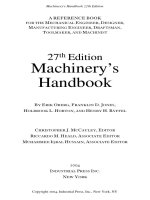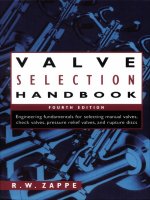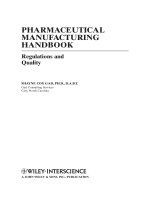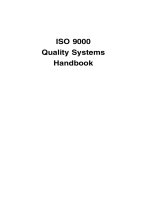WIKA handbook
Bạn đang xem bản rút gọn của tài liệu. Xem và tải ngay bản đầy đủ của tài liệu tại đây (6.61 MB, 436 trang )
HB001 - 1000 8/08
©2008, by WIKA Instrument Corporation.
All rights reserved.
WIKA Handbook
Pressure & Temperature Measurement
U.S. Edition
WIKA Instrument Corporation
1000 Wiegand Boulevard
Lawrenceville, GA 30043
Toll Free 1-888-WIKA-USA (945-2872)
Tel (770) 513-8200 Fax (770) 338-5118
• www.wika.com
WIKA Handbook
Pressure &
Temperature Measurement
U.S. Edition
WIKA-Handbook · Pressure and Temperature Measurement
U.S. Edition
I
15494_INTRO.P65
1
7/18/01, 18:28
II
15494_INTRO.P65
2
7/18/01, 18:28
WIKA-Handbook
Pressure and
Temperature Measurement
U.S. Edition
I
WIKA Instrument Corporation
1000 Wiegand Boulevard
Lawrenceville, GA 30043-5868
USA
A wholly owned subsidiary of:
WIKA Alexander Wiegand GmbH & Co.
Alexander Wiegand Straße
63911 Klingenberg
Germany
Original
Authors:
Scientific
advisers:
Editor for
U.S. Edition:
Printing:
Beckerath, Alexander von
Eberlein, Anselm
Julien, Hermann
Kersten, Peter
Kreutzer, Jochem
Prof. Dr. Fritz Aldinger
Johannes Dürr
Cameron Reebals
Corporate Printers, Cumming, GA 2008
©1998 WIKA Instrument Corporation. All rights reserved. No part of this book may be reproduced or
transmitted in any form, by any means (electronic, photocopying, recording, or otherwise) without the prior
written permission of the publisher.
Printed in the United States of America
IV
Foreword
For more than fifty years WIKA has been a leading manufacturer of pressure and temperature
measurement instruments.
Today, the name WIKA stands for a broad product range of industrial pressure and temperature
measurement instrumentation.
The more than 300 million measuring instruments made by WIKA so far not only prove the quality
of our products, but have also enabled us to gain an extensive knowledge of practical applications
requiring the measurement of pressure and temperature.
The present new edition of the WIKA handbook is intended to provide a reference book for our
worldwide customers, dealing not only with the fundamentals, but also important practical aspects
of industrial pressure and temperature measurement.
Additionally, all new developments concerning mechanical and electronic pressure and
temperature measurement are considered.
Alexander Wiegand
V
15494_INTRO.P65
5
7/18/01, 18:28
Introduction
Industrial development now faces challenges and opportunities of unprecedented magnitude and
diversity. Economical manufacturing processes for existing or new products, new technology trends, the
internationalization of markets and conditions of competition, new research developments and questions
of safety for man and his environment call for innovative and visionary solutions. In many cases the
optimum utilization of energy and raw materials, the reproducibility of product quality and the operational
reliability of plants and equipment depend essentially on being able to control fundamental operations
and parameters. Parameters of central importance in this respect are pressure and temperature. Their
simple and exact measurement and control are becoming more and more important for many fields of
technology and daily life. Indeed, they are already indispensable in heating, air conditioning, energy and
vacuum systems, in chemical processing, petrochemicals, paper manufacturing, the food industry and
biotechnology, and in automotive, mechanical, apparatus and plant engineering. The same appplies to
measurement and testing laboratories and to the equipment needed to conduct experiments for research
in the natural sciences and technology.
The success of measurement and control in the above mentioned fields depends greatly on the
availability of useful measurement methods and test facilities.
The WIKA Handbook sets out to present all the measurement methods and equipment now in use in
the technical field. In addition to reviewing the classical mechanical and electrical methods of measuring
pressure and temperature, the book also takes a detailed look at modern electronic sensor principles.
The measurement ranges of the instruments described extend from fractions of a millibar to 105 x
atmospheric pressure, with greatly varying demands on precision. As for temperature measurements,
the book describes methods for measuring the entire range from just above absolute zero to several
thousand degrees Fahrenheit.
In addition to describing the actual measurement methods and equipment the reader will also find
detailed information about the physical fundamentals of pressure and temperature metrology,
measurement transducers, influencing variables and the demands placed on pressure and temperature
instruments by process engineering. National and international standards and regulations are also
covered extensively.
In its comprehensive treatment of all pressure and temperature measurement aspects this handbook
is without equal. Details are presented in sufficient depth to grasp even complex subjects. Attention is
drawn to specialized literature and relevant handbooks on physics and metrology where additional
reading is required to answer further questions.
The WIKA Handbook will not only prove extremely useful for WIKA customers but will certainly also find
its way into many measurement and testing laboratories.
Prof. Dr. Fritz Aldinger
Scientific Member and Director
of the Max-Planck-Institute for Metal Research
and Full Professor at Stuttgart University
VI
15494_INTRO.P65
6
7/18/01, 18:28
Contents
1
1.1
Pressure measurement
Pressure and its units of measurement
1.1.1
1.1.1
1.1.2
Common units
Pressure of gases
Pressure of liquids
1.2
Types of pressure
1.2.1
1.2.2
1.2.3
1.2.4
1.3
1.3.1
1.3.1.1
1.3.1.2
1.3.1.3
1.3.2
1.3.2.1
1.3.2.2
1.4
1.4.1
1.4.1.1
1.4.1.2
1
1
1
2
3
3
3
3
4
Absolute pressure
Atmospheric air pressure
Pressure difference, differential pressure
Atmospheric pressure difference, overpressure
Common methods for measuring pressure
Direct pressure measuring instruments
Pressure measuring instruments with liquid column
• U-tube manometer
• lnclined-tube manometer
• Multiple liquid manometer
• Float-type manometer
Pressure balances with liquid separation
Piston-type pressure measuring instruments
• Piston-type pressure measuring instruments
• with spring-loaded piston
• Dead-weight pressure measuring instruments
Indirect pressure measurement instruments
Pressure measuring instruments with flexible elements
Electrical pressure sensors and pressure measuring instruments
• Sensor types with strain gauges
• Strain gauge transmission principles
• Diaphragm conversion
• Sensor principles with displacement measurement
• Other sensor principles
• Sensor principles for inspection and calibration systems
Pressure measuring instruments with
flexible measuring elements
Flexible measuring elements
Bourdon tubes
Diaphragm measuring elements
• Diaphragms
• Capsules
5
5
5
6
6
7
7
7
9
9
9
11
11
13
13
21
21
22
25
26
30
31
31
41
42
46
VII
15494_INTRO.P65
7
7/18/01, 18:28
1.4.1.3
1.4.2
1.4.3
1.4.4
1.4.4.1
1.4.4.2
1.4.4.3
1.4.4.4
1.4.5
1.4.5.1
1.4.5.2
1.4.6
1.4.6.1
1.4.6.2
1.4.6.3
1.4.6.4
1.4.7
1.4.7.1
1.4.7.2
1.4.7.3
1.4.7.4
1.4.7.5
1.4.7.6
1.4.7.7
1.4.7.8
1.4.7.9
1.4.7.10
1.4.7.11
1.4.7.12
1.4.7.13
1.4.7.14
1.4.7.15
1.4.7.16
1.4.8
1.4.8.1
Bellows
Movements
Dials and pointers
The case
Connection positions
Design types
• Modular design of commercial pressure measuring instruments
• Modular design for industrial measuring instruments
• Forged cases for liquid filling
Vibration damping by liquid filling
• Resonant frequencies and amplitudes
• Resistance to resonance
• Investigation of various instrument types
Safety of pressure measuring instruments
Electrical and pneumatic accessories
Alarm contacts
• Direct contacts
• Indirect contacts
Transmitters
• Potentiometric transmitter
• Capacitive transmitters
Special flexible element pressure measuring instruments
Pressure measuring instruments for absolute and differential pressure
• Differential pressure measuring instrument with diaphragm
• Absolute pressure measuring instrument with diaphragm
• Absolute pressure measuring instrument with capsule
Pressure measuring instruments with high overload capability
Pressure measuring instruments and pressure transducers for
ultrapure gases
Gas density monitors for SF6 systems
Special designs and optional accessories
Pressure measuring instruments for oxygen and acetylene
Calibration with other pressure media
Bourdon tube with tip bleed
Bourdon tube with filling
Extension of the lower scale range (retard scale)
Dual scales
Scales for direct measurement of force
Temperature scale
Scales with compensation for difference in levels
Luminous dials
Mark pointers
Drag pointers
Suppressed zero
Extended pointer shaft
Safety glass
Special protection during shipment
Measurement data and standards concerning applications
Full scale range and maximum operating range
VIII
15494_INTRO.P65
8
7/18/01, 18:28
48
48
52
54
54
55
55
56
57
58
58
59
60
63
66
66
66
68
69
69
69
72
72
73
73
74
75
76
77
79
79
79
79
80
80
80
80
81
82
83
83
83
83
84
84
84
84
84
1.4.8.2
1.4.8.3
1.4.8.4
1.5
1.5.1
1.5.1.1
1.5.1.2
1.5.1.3
1.5.1.4
1.5.1.5
Accuracy of the indication
Process fluids
Environmental conditions
Pressure transducers, pressure measuring
converters and pressure transmitters with
analog and digital circuits
Definition of a pressure transducer
Pressure transducers and their specifications
Pressure measuring converters
Technical data and their definition
• Measuring range / measuring span
• Overload pressure range
• Burst pressure
• Power supply
• Output signal (analog, digital)
• Response time
• Accuracy and conformity error
• Hysteresis
• Temperature ranges
• Compensated temperature range
• Types of electrical connection
Pressure transmitters
Differential pressure transmitter
1.6
Diaphragm seals
1.7
Selection, installation and initial operation
1.6.1
1.6.2
1.6.3
1.6.4
1.6.5
1.6.6
1.6.6.1
1.6.6.2
1.6.6.3
1.6.7
1.7.1
1.7.2
1.7.2.1
1.7.2.2
1.7.2.3
1.7.2.4
1.7.2.5
Diaphragm seal characteristic
Displacement volume and control volume
Practical applications
Response time
Computer-aided selection of diaphragm seals
WIKA diaphragm seal systems
Diaphragm seals
INLINE SEAL™ diaphragm seals
Capsule diaphragm seals
Summary
85
86
87
90
90
92
92
93
93
93
93
93
94
94
95
95
96
96
96
96
97
100
101
102
102
102
103
104
104
105
106
106
107
Checklist for selecting a pressure measuring instrument
107
Installation and operating instructions for pressure measuring instruments111
Accessories for the measuring point and attachments for pressure
measuring instruments
109
Shut-off devices
110
Mounting the measuring instrument in position
110
Damping the measuring system
110
Temperature considerations
110
IX
1.7.2.6
1.7.2.7
1.7.2.8
1.7.2.9
1.7.2.10
1.7.2.11
1.7.2.12
1.7.3
1.7.3.1
1.7.3.2
2
2.1
2.1.1
2.1.2
2.2
2.2.1
2.2.2
2.2.3
2.2.4
2.2.4.1
2.2.4.2
2.2.4.3
2.3
2.3.1
2.3.2
2.3.2.1
Chemical seals / Protective buffers
Protective devices
Measuring arrangements
Installation and start-up
Operation
Storage
Hazardous process fluids
Certification and testing
Certification of material tests
Calibration
110
110
111
112
112
113
113
113
113
114
Thermometry
Introduction to thermometry
Historical development of the thermometer
Historical development of the temperature scales
Principles and definitions of
temperature measurement
The thermodynamic temperature scale
Temperature and its units
The International Temperature Scale (ITS-90)
Measuring principles and sensors for temperature measurement
Measuring principles on the basis of thermal expansion of substances
Electrical temperature sensors
• Metal resistance thermometers
• Thermocouples
• Semiconductor sensors
• Radiation thermometers (pyrometers)
Additional temperature measuring techniques
• Optical measuring methods
• Crystal oscillator temperature sensors
• Acoustic measuring methods
• Temperature indicators
• Thermal noise thermometers
• Capacitive temperature sensors
• Inductive temperature sensors
Industrial direct-contact thermometers
Temperature measurement with direct-contact thermometers
Temperature measurement in liquids and gases
Installation conditions of thermometers
• Thermometer installation in pipes
• Thermometer installation in tanks or cylinders
• Thermometer installation in steam pipes
• Thermometer installation in flue gas ducts
X
15494_INTRO.P65
10
7/18/01, 18:28
119
120
121
121
122
123
124
125
129
129
131
131
132
135
139
140
140
142
143
144
144
145
146
148
148
149
149
149
150
150
151
2.3.2.2
2.3.2.3
2.3.2.4
2.3.2.5
2.3.3
2.3.3.1
2.3.3.2
2.4
2.4.1
2.4.1.1
2.4.1.2
2.4.1.3
2.4.2
2.4.3
2.5
2.5.1
2.5.2
2.5.2.1
2.5.2.2
2.5.3
2.6
2.6.1
2.6.2
2.6.2.1
2.6.2.2
2.6.2.3
Mechanical load
• Static loading by the hydrostatic pressure
• Dynamic loading of a thermowell exposed to flow
• Vibration load
Chemical resistance
• Resistance in oxidizing atmosphere
• Resistance in cases of oxygen deficiency
and in reducing atmosphere
• Resistance in aqueous media
Commonly used materials for thermowell
Standardized thermometers
• Standardized thermowells
• Standardized connection heads
Temperature measurement in solid bodies and on surfaces
Thermometer installation in solid bodies
Temperature measurement on surfaces
Temperature measurement variables
Heat transfer from the process to the thermometer
Thermal conductivity of substances
Heat transfer resistance at interfaces and phase boundaries
Transfer of heat by radiation
Immersion depth of the thermometer
Self-heating of electrical thermometers
Time response of contact thermometers
Time response in the water model
RC models for description of the dynamic behavior of thermometers
Thermometer with exponential transient response and the RC model
Basic circuit of R-C model in temperature measurement
Characteristic values for the time response
Industrial expansion thermometers
Glass thermometers
• Construction and types
• Parameters, errors and measuring uncertainties
Dial thermometers
Stem-type expansion thermometer
Bimetallic thermometers
• Construction and basic types
• Design of bimetals
• Parameters, errors and error limits
• Applications and technical designs
Spring thermometers
• Liquid spring thermometers
• Vapour pressure spring thermometer
• Gas pressure spring thermometers
151
151
152
153
155
155
155
155
156
157
158
161
162
162
163
164
164
164
165
171
174
175
177
177
177
177
179
181
184
184
184
187
190
190
192
192
193
195
197
198
199
202
203
XI
15494_INTRO.P65
11
7/18/01, 18:28
2.7
2.7.1
2.7.1.1
2.7.1.2
2.7.1.3
2.7.1.4
2.7.1.5
2.7.1.6
2.7.2
2.7.2.1
2.7.2.2
2.7.2.3
2.7.2.4
2.7.2.5
2.7.2.6
2.7.2.7
2.7.2.8
2.8
3
Electrical thermometers for
industrial applications
Platinum resistance thermometers
Construction of a platinum resistance thermometer
Platinum measuring resistors
• Ceramic measuring resistors
• Glass measuring resistors
• Film measuring resistors
Circuitry
Types of construction
• Industrial resistance thermometers with measuring elements
• Application-rated resistance thermometers
Measuring uncertainties of platinum resistance thermometers
• Self-heating error
• Instability and aging
• Effect of the insulation resistance
Standardization of industrial platinum resistance thermometers
Thermocouples
Construction of a thermocouple
Circuitry
Thermocouple pairings
Extension cables and compensating cables
Reference point compensation
Types of thermocouple design
• Technical thermocouples with measuring inserts
• Application-specific thermocouples
Measuring uncertainties of thermocouples
• Errors due to aging
• Errors due to inhomogeneities
• Errors due to the reference point and compensating cable
• Errors due to galvanic currents and faulty insulation resistance
Standardization and validation
• Basic value sets and tolerance classes
• Validability of thermocouples
Outlook and development trends for industrial
temperature measurement
Process engineering requirements for the
measurement of pressure and temperature
XII
15494_INTRO.P65
12
7/18/01, 18:28
208
208
208
209
210
210
211
212
213
213
214
217
217
217
217
218
218
219
219
219
221
221
221
221
222
224
224
225
225
226
227
227
228
229
231
3.1
3.1.1
3.1.1.1
3.1.1.2
3.1.1.3
3.1.1.4
3.1.2
3.1.2.1
3.1.2.2
3.1.3
3.1.3.1
3.1.3.2
3.1.4
3.1.4.1
3.1.4.2
3.1.4.3
3.1.4.4
3.2
Signal processing and transmission in the
measurement chain
Transducer signal conversion
Basic measuring methods for electrical sensors
• Resistance
• Voltage
• Frequency conversion method
Basic functions of transducers
Analog transmitter or transducer
Digital transmitter or transducer
• Frequency analog-digital conversion
• Parallel analog-digital conversion
• Approximation analog-digital conversion
• Integrative analog-digital conversion
• Design of a digital transmitter
Standardized analog signal transmission
Voltage transmission
Current signal transmission
Digital signal transmission
Standardized electrical digital interfaces
• Serial interfaces
• Digital parallel interfaces
Field bus systems
• Reference model OSI (Open System Interconnection)
Signal processing and evaluation
Analog and digital indicators
• Analog indicating systems
• Digital indicating systems
Stored program controllers (SPC)
Loop controllers
Computer-aided evaluation
Calibration
3.2.1
3.2.1.1
3.2.1.2
3.2.1.3
3.2.2
3.2.2.1
Introduction to calibration technology
Calibration, validation and adjustment
Calibration traceability
Uncertainty of measurement when calibrating
Calibrating pressure measuring instruments
Calibrating with deadweight tester
• Calibrating pressure gauges with low measurement uncertainty
3.2.2.2
Calibrating with the quartz Bourdon tube controller
• The quartz Bourdon tube manometer as working standard
• Calibrating pressure transmitters
Calibrating with mobile calibration units
Error explanations for calibrating pressure gauges
Calibrating temperature measurement instruments
3.2.2.3
3.2.2.4
3.2.3
231
232
232
232
232
233
234
236
237
237
238
238
239
241
243
243
243
246
246
246
248
249
249
250
250
250
252
253
254
255
256
256
256
256
257
258
259
260
260
260
261
261
262
263
XIII
15494_INTRO.P65
13
7/18/01, 18:28
3.2.3.1
3.2.3.2
3.2.3.3
3.2.4
3.3
3.3.1
3.3.1.1
3.3.1.2
3.3.1.3
3.3.1.4
3.3.1.5
3.3.2
3.3.3
3.3.3.1
3.3.3.2
3.3.3.3
3.3.3.4
3.3.3.5
3.3.3.6
3.3.3.7
3.3.3.8
3.3.3.9
3.3.4
3.3.4.1
3.3.4.2
3.4
3.4.1
3.4.1.1
3.4.1.2
3.4.1.3
3.4.2
3.4.2.1
Calibration by fixed points
• Standard resistance thermometer conforming with ITS-90
• Fixed point calibration
• Resistance measuring bridges
Calibrating by comparison measurement
• Calibrating in thermostatic baths
• Calibrating in dry block calibrators
• Calibration in temperature block calibrators
Error observations for thermometer calibrating
Calibrating result documentation
Electromagnetic compatibility
Basic physical definitions
Basic definition of EMC
Voltage interference
Current interference
Electromagnetic waves
• Frequency ranges of electromagnetic waves
Types of coupling for electromagnetic interference
• Physical couplings
• Normal mode and common-mode interference
EMC standards and regulations
Breakdown of measuring methods by defined interference
Radiated field
Bursts
ESD
Surge
Voltage interruption/voltage fluctuation
Conducted high frequency irregularities
Overhead power frequency interference (hum)
Residual ripple
Emitted interference radiation
Demands on equipment behavior in industry
Equipment behavior classification when exposed to interference
The CE symbol
Explosion protection on electrical measuring devices
Basic terms and definitions
Historical development
Basic terms of physics
Standards and regulations
• Technical characteristic safety parameters
• Types of protection
Design rules for intrinsic explosion protected measuring devices
Electrical regulations
• Minimum ignition energy
• Power limitation
• Energy storage limitation
XIV
15494_INTRO.P65
14
7/18/01, 18:28
264
264
266
267
268
268
272
274
275
277
278
278
278
278
278
279
279
279
279
279
280
282
282
283
284
284
285
286
286
287
287
287
288
288
293
293
293
294
295
296
297
300
300
300
300
301
3.4.2.2
3.5
4
4.1
4.1.1
4.1.1.1
4.1.1.2
4.1.1.3
4.1.2
4.1.2.1
4.1.2.2
4.1.3
4.1.3.1
4.1.4
4.1.4.1
4.1.4.2
4.1.4.3
4.1.5
4.1.5.1
4.1.5.2
4.1.5.3
4.1.6
4.1.6.1
4.1.6.2
4.1.6.3
4.1.7
4.1.8
4.1.9
4.2
4.2.1
4.2.2
4.2.2.1
4.2.2.2
4.2.2.3
Design rules
• Distance conditions
• Materials and material properties
302
302
302
Chemical resistance
304
Appendix and tables
307
National and international standards and
specifications
Pressure measuring instruments with an elastic
measuring element and accessories
German standards and specifications
International standards and specifications
Non-German standards and specifications
Flanges, connections and fittings
German standards and specifications
Non-German standards
Electrical measuring instruments and pressure gauges
German standards and specifications
Thermometers, temperature gauges and accessories
German standards and specifications
International standards and specifications
Non-German standards
Electrical temperature measuring instruments
German standards
International standards
Non-German standards
Further standards and specifications concerning general
measuring systems
German standards and specifications
International standards and specifications
Non-German standards
Standards and specifications with contents applying to safety
Further information is to be found in:
Contact addresses for standards and specifications
Tables and overviews
Tables of legal units
Conversion factors for commonly used pressure units
SI units - Technical units (metric)
SI units - Technical units (inch based)
Technical units (metric) - Technical units (inch based)
307
307
307
312
312
319
319
323
327
327
329
329
332
333
338
338
340
340
342
342
342
345
346
346
348
349
352
352
357
357
358
359
XV
15494_INTRO.P65
15
7/18/01, 18:28
4.2.3
4.2.4
4.2.5
4.2.6
4.2.7
4.2.8
4.2.9
4.2.10
4.2.11
Refrigerants
pH values of various solutions at 68∞ F
Boiling and melting point of various process fluids at 29.92 "Hg
Density of process fluids
Types of enclosure for cases (NEMA and IP)
Common materials of pressure gauges
Comparison of corrosion-resistant steels between
international standards
Corrosion resistance table
WIKA part numbering system for mechanical pressure gauges
360
362
363
364
366
368
370
371
398
4.3
Legend of symbols used
400
4.4
Abbreviations
409
4.5
Literature, sources
411
4.6
Index
417
XVI
1 Pressure measurement
1 Pressure measurement
1.1 Pressure and its units of
measurement
Pressure and temperature are among the most
important physical variables. Pressure is defined
as a force acting evenly over a given area.
Pressure =
Force
=
Unit Area
F
A
(1-1)
This force can be exerted by liquids, by gases or
vapors, or by solid bodies. Surface compression
takes place at the interface between two solid
bodies, but for our purposes we can consider this
additional force negligible.
The basic unit of force in the U.S. is the Poundforce (lbf) which is the force exerted by one pound
of mass.
SI - Le Système International d'Unités - (meter,
Newton, second, ampere) - Commonly used in
Europe and now popularly known as "metric"
units. SI units of pressure include bar, mbar, Pa,
kPa, MPa, and N/m2.
MKSA (meter, kilogram-force, second, ampere) formerly known as "metric" units but are generally
being replaced by SI units. MKSA units of pressure include kg/cm2, m H2O, mm Hg, and torr.
1.1.2 Pressure of gases
The molecules of a gas can be imagined as small
spheres moving randomly in a closed container.
As they move, they bounce off of each other and
off of the container walls, which creates pressure.
If we take one square inch (in2) as the basic unit
of area, then we can define pressure as:
Pressure =
lbf
= lbs. per sq. inch (PSI) (1-2)
in2
Pressure can also be expressed in terms of metric (SI) units. The basic metric unit of force is the
Newton (N) and the basic unit of pressure is the
Pascal (Pa).
Figure 1.1
Molecular motion in gases
1.1.1 Common Units of Pressure
There are three general classifications for units of
pressure measurement as follows:
Customary (inch, pound-force, second, ampere)
- used primarily in English speaking countries, but
in many countries are being replaced by SI units.
Customary units of pressure include PSI, in. Hg,
in. H2O, and oz/in2.
1
15494_001-010.P65
1
7/18/01, 18:33
1 Pressure measurement
If m (lb) is the mass of a molecule of the gas, vmed
(ft./s) the average molecular velocity and n the
number of molecules contained in 1 ft3, then the
pressure p is:
p=
1
3
2
n • m • v med
(1-3)
1.1.3 Pressure of liquids
Unlike gases, liquids have a very low level of compressibility. For most applications, liquids can be
assumed to be incompressible. Due to their elasticity, liquids revert back to their original volume
when a pressure is removed.
Therefore the pressure of a gas depends on
- the number of gas molecules
- the mass of the gas molecules
- the average velocity of the gas molecules.
When a gas is heated, its average molecular velocity increases and the gas pressure rises.
This molecular mobility also explains the tendency
of a gas to fill the entire volume of space available
(referred to as gas expansion). It also means that
a pressure exerted on a point of the container is
equally distributed on all sides. The distribution
of pressure takes place at the speed of sound.
Compared to solids and liquids, gases have a high
level of compressibility. This relationship between
volume V and pressure is described by Boyle’s
law:
V • p = constant
(1-4)
When a liquid in a closed container is pressurized,
its pressure is distributed equally to all sides just
like gases. The distribution of pressure in liquids
also takes place at the speed of sound.
Pressure in a liquid is called hydrostatic pressure. Since a liquid has a non-negligible mass, the
force exerted by its weight generates a pressure
that is independent of the shape of the container.
It's pressure is determined by the height of the liquid column and its mass density ρm by the following relationship:
∆ P= P1 – P2 = ∆ h • ρm • g
where g = gravitational force
The U-tube manometer, the oldest pressure measuring instrument, was created based on this principle.
where the temperature is assumed to be constant.
Combining this law with Gay-Lussac’s law leads
to the ideal gas law:
p•V
= constant
T
(1-5)
An important measurement, particularly for safety
reasons, is the energy W of pressurized gases. At
a volume V0 the energy of a gas at pressure Pe
compared to the ambient atmospheric pressure
Pamb is:
Wgas = Pe • V0 • ln
Pe
Pamb
(1-6)
2
15494_001-010.P65
2
(1-7)
7/18/01, 18:33
1 Pressure measurement
1.2 Types of pressure
The different types of pressure differ only with respect to their reference point.
1.2.1 Absolute pressure
The most definite reference point is absolute zero
pressure. This is the pressure of empty space in
the universe. When a pressure is based on this
reference point, it is called absolute pressure. To
distinguish it from other types of pressures it is
accompanied by the suffix "a" or "abs" (from the
Latin: absolutus = independent, separate from).
1.2.2 Atmospheric pressure
Figure 1.2 Liquid head manometer
The energy stored in a pressurized liquid is less
than the energy of a pressurized gas by several
orders of magnitude. If the liquid has a compressibility of χ, its stored energy is
WLiq =
1
2
χ • VO • pe2
The most important pressure for life on earth is
atmospheric air pressure pamb (amb = ambiens,
surrounding). It is produced by the weight of the
atmosphere surrounding the earth up to an altitude of about 300 miles. Atmospheric pressure
decreases continuously up to this altitude until it
practically equals zero (full vacuum). Atmospheric
air pressure undergoes climatic changes, as
shown by the daily weather report. At sea level,
pamb has an average value of 29.90 inches of Mercury ("Hg). In high or low pressure weather zones
it can fluctuate by as much as ± 5%.
(1-8)
1.2.3 Differential pressure
3
A comparison of 1 in of water with an equal volume of gas at an overpressure of 15 PSI, shows
the difference clearly:
WLiq = 1.5 x 10-5 in.-lbs
Wgas = 2.1 x 10-1 in.-lbs.
(1-9)
The difference between two pressures P1 and P2
is referred to as the pressure differenential
∆P = P1 - P2. The difference between two
independent pressures is called the differential
pressure.
3
15494_001-010.P65
3
7/18/01, 18:33
1 Pressure measurement
Figure 1.3 Types of pressure
1.2.4 Gauge Pressure and Vacuum
The most common measurement of pressure is
gauge pressure (Pg) which is the pressure difference between the measured pressure and ambient pressure.
pg = pmeas. - pamb
(1-10)
The term pressure is used if the measured pressure is higher than the atmospheric pressure.
The term vacuum is used if the measured pressure is below atmospheric pressure.
The use of either of these terms automatically
implies that the pressure (or vacuum) being measured is with respect to ambient pressure (i.e.
gauge pressure or vacuum). In order to distinguish absolute pressure measurements, the
words "absolute pressure" must be used.
1.3 Common methods for
measuring pressure
Accurately measureable pressures can vary from
fractions of an inch of water (very low pressure) to
over 100,000 PSI (extremely high pressure). The
degrees of accuracy needed at these pressures
also vary by application. To cover these variables,
there are two basic types of pressure measurement; direct and indirect.
Direct-measuring pressure instruments determine the pressure from the basic equation:
p=
F
A
or ∆ p = ∆ h • ρm • g
and get their readings from these relationships.
Indirect-measuring pressure instruments use
the deflection of a flexible material or an electrical,
optical or chemical effect to determine the measured pressure. Measuring converters are instruments which convert the pressure acting on them
into an output which is generally an electric or
pneumatic signal. This output is a function of the
input pressure and can be either digital or analog.
4
15494_001-010.P65
4
(1-11)
7/18/01, 18:33
1 Pressure measurement
1.3.1 Direct-measuring pressure instruments
1.3.1.1 Pressure measuring instruments
using a liquid column
(Liquid column manometers)
The measuring principle of a gauge using a liquid
column, commonly referred to as a liquid column
manometer, consists of comparing the pressure p
being measured with the height h of a liquid column using the law
∆ p = ∆ h • ρm • g
(1-1)
The height of the liquid column h is read from a
graduated scale. If higher precision is needed or
if the measurement signal is to be processed further, the height difference is measured by a resistance wire inserted into the liquid or by the reflection of sound or light waves.
curacy, significant corrective calculations are
needed. Corrective calculations are also necessary if the temperature differs from the reference
temperature. Factors such as temperature-dependent changes of the liquid's density, differences in
the length of the scale and deviations of the factor of gravitational acceleration at the point of
measurement must be taken into account. Contamination of the liquid also leads to density
changes and a corresponding error in measurement. Furthermore, the influence of surface tension and its possible change due to external effects must also be taken into consideration, as
well as the compressibility of the liquid.
The surface tension of a liquid is evident by its
curved surface (meniscus) against the container
walls. In small diameter tubes the entire surface
will be curved. With liquids such as water or alcohol, which have a relatively low surface tension,
the surface will be concave (Figure 1.4).
Selection of the liquid depends on the magnitude
of the measured pressure. Commonly used liquids
are alcohol, water and mercury. With a liquid
column of 3 ft. as the practical height limit, the
different densities of alcohol with ρm ~ 0.5 oz./in3,
water with ρm ~ 0.6 oz./in3 and mercury with
ρm ~ 8.2 oz./in3 result in the following measurement
pressures:
Alcohol
Water
Mercury
16.66 oz./in2
20.82 oz./in2
283.2 oz./in2
These values show that a pressure measuring
instrument with a liquid column is practical for the
measurement of low pressures and vacuums or
small pressure differences. Pressure difference
measurements can also be made at high static
pressures, as long as the tubes are designed to
handle those static pressures.
Because of their reliability, liquid column manometers are fairly common.
The accuracy of measurements taken at room
temperature with instruments based on the liquid
column principle is approximately 0.3%, regardless of the point of measurement. For higher ac-
Figure 1.4 Formation of a meniscus in liquids
With mercury, which has a very high surface tension, the meniscus is convex. To avoid any ill effects of capillary elevation in small diameter tubes,
liquid manometer tubes have a constant diameter.
To avoid parallax errors when reading the pressure, the reading must be taken in the horizontal
direction at the apex of the meniscus (Figure 1.5).
Precision instruments have a mirror graduation or
some other auxiliary device to ensure precise
readings.
5
15494_001-010.P65
5
7/18/01, 18:33
1 Pressure measurement
U-tubes are built for pressures of between 4 "H2O
and 10,000 PSI. The maximum pressure differences ∆p depend on the length of the tubes and
on the density of the liquid.
lnclined-tube manometer
The inclined-tube manometer is used to measure very low pressures of up to about 4 "H2O.
Figure 1.5
Parallax reading error
U-tube manometer
Liquid column manometers come in various configurations to meet specific requirements. The
basic types are described below. The simplest liquid column manometer is the U-tube manometer.
The sloping design of the tube stretches the
graduation by an amount proportional to the angle
of inclination α. For this reason, the angle of inclination of many inclined tube manometers can be
adjusted. With unequal areas A1 and A2, the
graduation will need to be corrected accordingly
due to the changing level of liquid at A1. For high
precision, the measurement must be made very
carefully. Generally these instruments are
equipped with a bubble leveler for precise horizontal adjustment.
Figure 1.7
Figure 1.6
Inclined-tube manometer
U-tube manometer
When the pressures p1 and p2 are equal, the
height difference ∆h - and therefore ∆p - is zero.
With the same internal diameter, surface consistency and material, the capillary elevation has no
effect.
6
15494_001-010.P65
6
7/18/01, 18:33
1 Pressure measurement
Mulitple liquid manometer
A mulitple liquid manometer allows magnification of the measuring range by a factor of 8 to 10
because the measurement is based solely on the
difference of the two densities.
Figure 1.9 Float-type manometer
A float S follows the height of the liquid column
and relays this height to the outside.
∆p = ∆h (ρm2 - ρm1) · g
(1-13)
Figure 1.8 Mulitple liquid manometer
With multiple liquid manometers it is important
that the separating liquids not mix with each other
nor with the process fluid. If the process fluid
density ρm and the separating liquid density ρm1
differ, the change of height of the upper liquid level
must be taken into account. This is particularly
important for the measurement of gas pressures.
This design allows the instrument to be made of
metal for operating pressures from 10"H2O to
6000PSI. The measuring range can be changed
by reversing the ratio A1 : A2. The main problem
with this type of instrument is that the friction
occuring from the pressure-tight transmission of
the measurement results adds error to the
reading. Additional equipment can be added to the
float-type manometer that determines the position
of the float from the outside (i.e. ultrasonics) which
then transmits the results to the graduated scale.
However, even this additional equipment is not
enough to maintain this instrument's former
popularity.
1.3.1.2 Pressure balances with liquid
separation
Float-type manometer
The float-type manometer tries to combine the
advantages of easy reading on a graduated scale
with the advantages of a liquid column.
Pressure balances differ from the liquid column
manometers described in Section 1.3.1.1 in that
the separating liquid is used only to keep the pressure chambers apart. The pressure being
7
15494_001-010.P65
7
7/18/01, 18:33
1 Pressure measurement
measured acts on a defined area A and is compared with a force due to weight G. Changes of
density of the separating liquid do not affect the
measurement.
The measuring principle of the pressure balance
is best demonstrated by the immersed bell.
G=m·g
p=
m•g
(1-14)
A
Figure 1.10 Immersed bell pressure
measuring instrument
Figure 1.12 Immersed cylinder pressure
measuring instrument
Replacing the reference weight G with a spring
force results in a rotary movement that is proportional to the pressure and which can be displayed
on a graduated scale for simple reading of the
measurement.
The immersed bells shown here are used for the
measurement of small pressures up to 0.5"H2O
with an accuracy of approximately 0.03%.
Figure 1.11 Immersed segment
pressure measuring
instrument
Figure 1.13 Cylindrical pressure balance
8
15494_001-010.P65
8
7/18/01, 18:33









